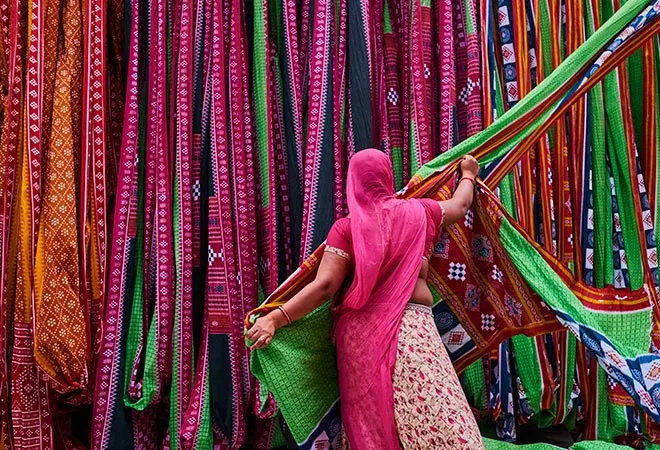
Pandemics and epidemics affect men and women differently, just like conflicts affect men and women differently. The 2014 Ebola virus and 2015-16 Zika virus in Brazil reinforced long standing gender inequity. Factors such as the proportion of health workers, the proportion of home-based workers, and proportion of caregivers have a remarkable impact on the share of those infected by the virus. How far has the COVID-19 pandemic created a lopsided footprint in India? It is important to consider gender differences in preparedness and response to the outbreak, because the reverberations are dependent on both social and physical dimensions.
Women, work, and COVID19
70 percent of the world’s healthcare and social workers are women, which means they are not only the first responders for mitigating the outbreak, but also front in line for catching the disease. According to the 68th round of the National Sample Survey’s report on employment in India, estimates of the health workforce shows that qualified female health workers constitute almost half of the qualified health workforce. Among different categories of health workers, qualified nurses and midwives were dominated by women at 88.9 percent.
While escalating work from home policies and schools having shut down worldwide may be seen as an untimely summer vacation, it is an added burden on caregivers who are mostly women. The Periodic Labour Force Survey (PLFS) of India, released by the “Ministry of Statistics and Programme Implementation” in 2019, indicated that the only sector which has a larger number of women getting vocational training is work related to childcare, nutrition, pre-school, and crèches. Women trainees are 18.0 percent, while 1.2 percent of men get trained in this area. With schools shutting down, the burden on this part of the workforce increases exponentially.
Furthermore, several states across the country have asked Accredited Social Health Activists (ASHA) and Anganwadi workers to check up on families in their areas for symptoms, and hold advisory sessions for precautionary measures against COVID-19. However, according to reports, associations of ASHA have approached the central government to provide adequate equipment to them, which they are currently lacking. ASHA make up almost one million female community health workers, and Anganwadi workers comprise 1.4 million women.
In India, most women are in home-based work, and self-employment in women is also high; these trends are important indicators of the effect of a pandemic like COVID-19. 31.7 percent of women in the non-agriculture sector were home-based workers, compared to 11 percent of men. While this could mean a regular day at work as opposed to others changing to a ‘work from home’ routine, many of the home-based workers are also self-employed which means they would be unable to avail of any employee pandemic benefits given by companies. The PLFS tracks the number of workers in the informal sector, among the workers in the non-agriculture sectors and relevant agricultural sectors (such as animal production, aquaculture, fishing, and support activities to agriculture). According to the survey, among female workers, informal workers accounted for 54.8 percent of the workforce. This furthers the concept that women are disproportionately affected by COVID-19 as they would lose more work and not receive the benefits of contractual paid leave policies.
Women, access to health, and COVID-19
Often, womens’ needs become a matter of secondary importance and essential resources for sexual and reproductive healthcare (SRH) are diverted to emergency responses. Large-scale disease outbreaks can exacerbate the lack of reproductive and sexual health services. Although no evidence has been found regarding the effect of Covid-19 on pregnant women, studies indicate that pregnancy has been a high-risk factor for increased illness and death during pandemics. During the outbreak of Ebola, it was observed that there was a general lack of knowledge about how the virus affects pregnant women in Africa. Frontline health workers, such as midwives, struggled due to a lack of clinical guidelines and information on caring for pregnant women in the context of Ebola. Additionally, during the Ebola epidemic, institutional births dropped by 30 percent and the maternal mortality rate increased 75 percent across Guinea, Sierra Lione and Liberia. A high maternal mortality rate due to the absence of antenatal care (ANC), and lack of skilled and emergency obstetric care, makes COVID-19 preparedness more challenging for India. The NFHS-4 data indicates that only 21 percent of women across the nation have received full ANC. It also highlights that only 36.4 percent of mothers received financial assistance under Janani Suraksha Yojana for births delivered in a public institution. Although India has so far escaped the worst of the pandemic, it is crucial to recognise the urgency of integrating the requirements of vulnerable populations, including pregnant women in the pandemic preparedness.
Across the world, COVID-19 has overwhelmed the healthcare systems, which may have a dangerous impact on SRH and its rights. Due to the outbreak, supply chains around the world have been disrupted. China, as a result, has shut down several drug-manufacturing plants, which has led to delays at Indian factories that produce generic medicines. This can cause shortages of medicines such as contraceptives, antibiotics to treat sexually transmitted diseases and antiretrovirals for AIDS/HIV. The inaccessibility of these drugs, in turn, may cause prices to rise and affect impoverished women who seek to undergo an abortion or prevent exposure to the virus during their pregnancy. A similar outcome was recorded in Brazil where the Zika virus outbreak caused shortages of medical abortion pills and contraceptives. As a result, children with Zika infection-related disabilities were disproportionately born to women of low socio-economic status in Brazil.
Women, education, representation, and COVID-19
UNESCO estimated that 107 countries have closed their educational institutions nationwide, impacting over 861.7 million children and youth. The spread of COVID-19, however, may further the gender divide in education. The adverse effects of school closures are often higher with respect to girls’ education. For example, Sierra Lione witnessed a large number of girls dropping out of schools post the Ebola epidemic.
Women make up most of the frontline health professionals, however, their engagement is low in global health security surveillance, detection, and prevention mechanisms. For instance, the WHO-China joint mission on COVID-19 has only three women out of 25 members, which reflects an inadequate women’s representation in the COVID-19 policy space at a global level. In India, the COVID-19 Economic Response Task Force is headed by the Finance Minister, Nirmala Sitharaman who is a woman. However, there are only two women in the 21 member Committee for Public Health Experts on COVID-19 constituted by the Indian Council for Medical Research.
Including women’s voices and knowledge could be empowering, improve outbreak preparedness and a better-gendered approach to the crisis. The response to the spread of COVID-19 must take into account the different impact on vulnerable populations, including women. The global community must share lessons, learn best practices, and ensure that no effect is too adverse.
The views expressed above belong to the author(s). ORF research and analyses now available on Telegram! Click here to access our curated content — blogs, longforms and interviews.




 PREV
PREV


